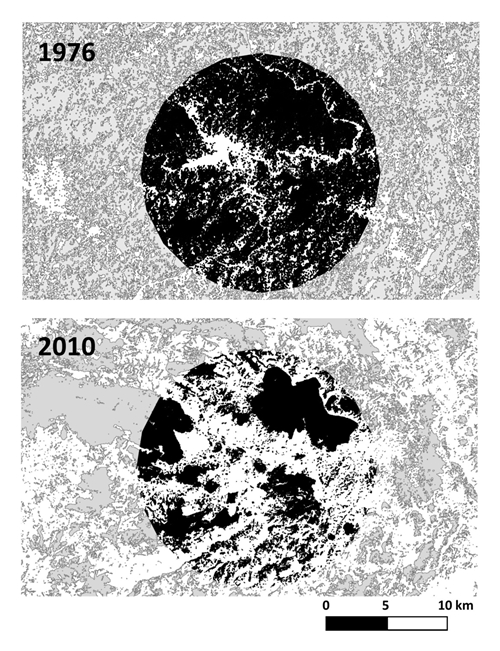狩猎强度通常会随着森林破碎化的加剧而增加,狩猎强度和森林破碎化程度都会导致物种灭绝,但是对它们的独立影响却少有探究。
版纳植物园动物行为与环境变化研究组硕士研究生Sreekar
本研究发现,34%的鸟类在研究区域内已经绝迹,而且乡村与矩阵校正的森林鸟类SAMs的估量斜率比无狩猎的期待值0.35分别高出1.4和1.7倍。研究还发现鸟类的灭绝可能性与它们的体型显著相关,而那些被认为对森林片段化非常敏感的林下食虫鸟类与食果鸟类对狩猎的敏感度却比较低。已有证据显示该研究地区在过去和现在均有狩猎活动存在,除此之外似乎缺乏其他的可能原因,研究认为狩猎增加了约1.3到1.6倍的森林鸟类灭绝率。本文认为在热带森林片段化景观中,狩猎效应实际上增加了物种的灭绝率,因此仅仅采取森林采伐(即扩展保护区域网络)的保护措施是不充分的。
相关研究结果以The use of species–area relationships to partition the effects of hunting and deforestation on bird extirpations in a fragmented landscape为题发表在国际期刊Diversity and Distributions上。

西双版纳勐仑1976年(上)和2010(下)景观图。 圆形部分是调查区域的历史和现状,黑色代表森林,白色代表橡胶林和人类活动区域。圆半径为10 Km。
The use of species–area relationships to partition the effects of hunting and deforestation on bird extirpations in a fragmented landscape
Aim Forest fragmentation is often accompanied by an increase in hunting intensity. Both factors are known drivers of species extirpations, but understanding of their independent effects is poor. Our goal was to partition the effects of hunting and fragmentation on bird species extirpations and to identify bird traits that make species more vulnerable to these two stressors.
Location Menglun, Yunnan, SW China
Methods We studied the landscape within 10 km radius of Menglun town, where forests have become highly fragmented by monoculture rubber plantations. We compiled data on birds recorded between 1954 and 1983 before forest loss and compared it with a checklist prepared between 2011 and 2014. We used countryside and matrix-calibrated species–area models (SAMs) to estimate the observed slope of forest bird extirpations in Menglun and compared it with the slope expected in the absence of hunting. We also investigated six ecological traits to determine those that best explained bird extirpation probability (EP).
Results We found that 34% of the bird fauna had been extirpated from the study landscape, and the estimated slopes of countryside and matrix-calibrated SAMs for forest birds were around 1.4 and 1.7 times higher, respectively, than the 0.35 expected without hunting. Bird EP was strongly associated with size, and understorey insectivores that are known to be susceptible to fragmentation were less susceptible to hunting than frugivores. Given evidence of past and present hunting activity in the area, and the lack of support for alternative explanations, we suggest that hunting increased forest bird extirpations by around 1.3- to 1.6-fold.
Conclusions This study highlights the importance of using species–area relationships to separate area effects from the impacts of hunting. Our results suggest that hunting substantially increases species extirpations in tropical fragmented landscapes and conservation interventions that only target deforestation will therefore be inadequate.